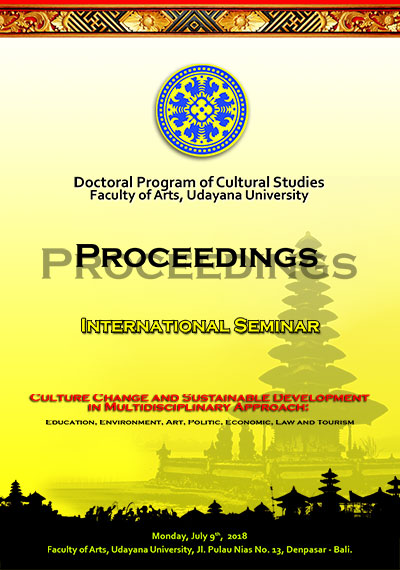UPIN IPIN ANIMATED ANIMATION: THE ROLE OF MEDIA IN CHANGE LANGUAGE CHILDREN OF BALI CHILDREN
Abstract
Upin Ipin is one of the animation entertainment that aired by television media. Upin Ipin is loved by children today, not least children in Bali. Animation Upin Ipin is not only as an entertainment, but it is able to influence the use of language, especially for children in Bali. Changes in the greater and widespread language dialects will have implications for the local and Indonesian language marginalization. This article aims to discuss the role of the media, especially television that has been able to influence the language dialects of children in Bali. The logic of the analyzed language is the change of everyday language and behavior along with the implications felt by the parents. The data were taken through observation and in-depth interviews. Observations conducted on Balinese children who tend to watch animation Upin Ipin through television media. Similarly, in-depth interviews of parents of children who have been affected by the language of Upin Ipin. The research method used qualitative method with qualitative interpretative approach. This study uses the theory of habitus proposed by Bourdieu. The results of the study show that television media is quite instrumental in influencing the language and behavior of children in Bali. Some parents feel uncomfortable with changes in their children's language dialects. They fear that regional languages will become increasingly marginalized later. Changes that occur is the implication of the animated show Upin Ipin is enough to dominate other events. Frequently hearing the language and seeing the behavior of Upin Ipin become seeping into the minds and feelings of the children. Therefore automatically form the knowledge naturally. Knowledge gained becomes intertwined so as to change the way of speech, attitude and behavior.
Downloads
References
Burton, Graeme. 2006. Yang Tersembunyi Di Balik Media: Pengantar Kajian Media. Yogyakarta: Jalasutra.
Danesi, Marcel. 2010. Pengantar Memahami Semiotika Media. Yogyakarta: semiotika media Ghani, Abdul, D.B. 2015. Upin & Ipin: Promoting malaysian culture values through animation. Jurnal Histo-ria y Comunicación Social. Vol 20, No. 1, Halaman 241-258.
Harahap, Machyudin Agung. 2013. Kapitalisme Media: Ekonomi Politik Berita dan Diskursus Televisi. Yogyakarta: Aura Pustaka.
https://www.viva.co.id/berita/nasional/134551-upin-dan-ipin-ramaikan-perayaan-nyepi, accessed on May 12, 2018
https://www.youtube.com/watch?V=Gjb9_-cbdXU, accessed on May 10, 2018 https://www.youtube.com/watch?V=HGXZCI3z_24, accessed on May 10, 2018 https://www.youtube.com/watch?V=QqxFGFJVsMw, accessed on May 12, 2018 Lubis, Akhyar Yusuf. 2014. Posmodernisme: Teori dan Metode. Jakarta:Rajawali Pers. Nuswantoro, A. Ranggabumi. 2012. Rasa Lokal Rejeki Internasional: “Betul, Betul, Betul” Aspek Ekonomi Politik dalam Kartun Animasi Upin dan Ipin. Jurnal Komunikasi, Vol. 1, Nomor 5.
Piliang, Yasraf Amir dan Jejen Jaelani.2018. Teori Budaya Kontemporer: Penjelajahan Tanda Dan Makna. Yogyakarta: Aurora.
Rahim, Normaliza Abd. dkk. 2014. Learning via Television Cartoon. Jurnal Asian Social Science. Vol.10, No.15
Ritzer, George dan Douglas J. Goodman. 2004. Teori Sosiologi Modern. Jakarta: Kencana Rusadi, Udi. 2015. Kajian Media: Isu Ideologis Dalam Perspektif, Teori Dan Metode. Depok: rajawali pers.
Takwin, Bagus. 2009. Akar-Akar Ideologi: Pengantar Kajian Konsep Ideologi dari Plato Hingga Bourdieu. Yogyakarta: Jalasutra
Wallach, Jeremy, dkk. 2014. Komunikasi Dan Komodifikasi: Mengkaji Media Dan Budaya Dalam Dinamika Globalisasi. Jakarta: Yayasan Pustaka Obor Indonesia

This work is licensed under a Creative Commons Attribution-NonCommercial-ShareAlike 4.0 International License.





